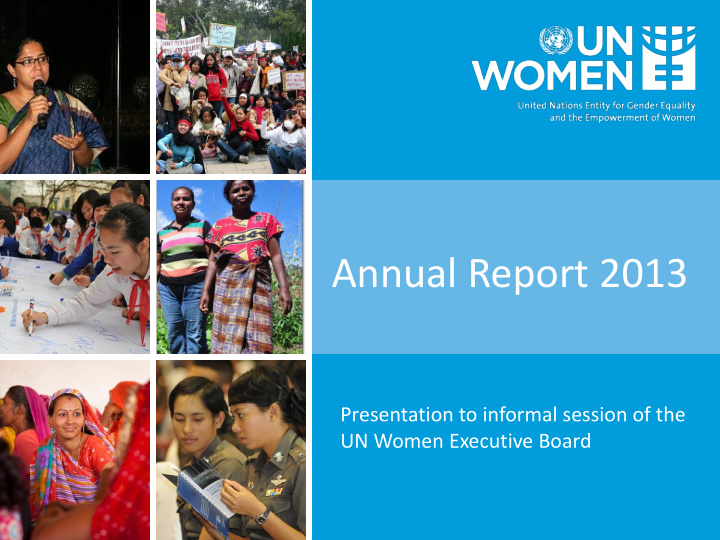



Annual Report 2013 Presentation to informal session of the UN Women Executive Board
STRUCTURE Starting with normative, coordination and cross-cutting areas. Then moving to specific thematic areas. Better captures link between different aspects of the mandate. We have retained trajectory charts from last year + added traffic light tables to summarize progress against MRF targets. QCPR integrated through the report
OUTLINE Context UN Women’s normative role and how we work with the UN system, our partnerships and advocacy, RBM and evaluation. UN- Women’s results: SP priority areas 1-5 Organisational effectiveness and institution building: structural reform + improvements in operations and business processes. Income and expenditure
QCPR Reporting on the QCPR is integrated through the report. The QCPR is central to the Entity’s approach to coordination and to strengthening system- wide delivery on gender equality and women’s empowerment. In 2013 UN-Women prioritized alignment between its new strategic plan, 2014-17 and the QCPR. Throughout 2013, UN-Women contributed to timely follow-up to the resolution through the UNDG and its various mechanisms. This included contributing to an action plan on QCPR implementation and contributing to the M&E framework. From next year the Entity will report on the new Strategic Plan 2014-17 which is a fuller reflection of the integration of QCPR priorities into UN Women’s work.
COUNTRY COVERAGE
Countries where UN-Women provided support: 2011-2013
DEVELOPMENT RESULTS BY PRIORTY AREA
Political Participation and Leadership
Economic Empowerment
Ending Violence against Women
Women, Peace and Security
National Planning and Budgeting
Normative Frameworks Security Council resolution 2122 – strengthening language from SCR 1325 4 GA Resolutions on gender equality ECOSOC ministerial declaration – Science, technology and innovation for MDGs 5th Tokyo International Conference on African Development – gender equality Open Working Group of the General Assembly on Sustainable Development Goals Declaration by the Peacebuilding Commission and Arms Trade Treaty
UN Coordination UN System Wide Action Plan on Gender Equality and Women’s Empowerment (SWAP) Support to QCPR Coordinated UN System support on gender to Rio+20, CSW, and post-2015 Active participation in Delivering as One Leadership/Participation in 91 UNCT Gender Theme Groups Inter-Agency and Expert Group on Gender Statistics
SWAP
MANAGEMENT RESULTS
Organizational Effectiveness Strengthening the field: 6 MCOs, 6 Ros and 48 COs. Recruitment of 14 new Representatives. Full Delegation of authority issued to 38 offices. IPSAS implementation Improved guidance and oversight tools and processes
Resource Mobilization Key Challenge in 2013 and ahead Funding targets missed 11% increase in the number of donors compared to 2012 18 governments increased their contributions 1 new national committee (France)
Revenue and Expenses
Expenses by geographic region These figures are unaudited and subject to change.
Challenges Resources Expectation are high, pressure for immediate impact Ensuring there is no push-back on the normative agenda Ensuring GEWE is robustly addressed in post- 2015 development agenda
Conclusion Our mandate and role make us uniquely positioned to deliver for women Achieved a great deal in 2013 Will continue to build capacity and ability to leverage normative and operation roles. Beijing+20 is an important opportunity to look at achievements and challenges.
Recommend
More recommend